 |
|

|
 |
TABLE of CONTENTS
 |
2013 construction season saw a variety of work on more than 300 projects |
By Rich Kemp
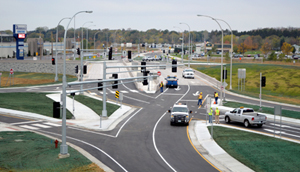
Crews completed a diverging diamond interchange in October at the Hwy 15 and County Road 120 intersection in Sartell and St. Cloud. Photo by Blake Redfield, city of St. Cloud |
As the 2013 construction season winds down, major bridge construction, new interchanges and road resurfacing were a big part of this year’s projects. It included more than 300 projects around the state with a construction cost of more than $1.1 billion.
The 2013 construction program included work on 87 highway and bridge projects in the Twin Cities and 193 highway and bridge projects in Greater Minnesota. An additional 57 projects statewide focused on improving safety at railroad crossings, repairing seawalls and docks, improving runways and terminals at regional airports, and improving transit centers.
“We started this season with more than 300 projects on the schedule,” said Commissioner Charlie Zelle. “Many of the projects are now complete. The work is providing safer, smoother roadways and is maintaining the transportation network that is so vital to our state’s economy and quality of life.”
Projects in the Twin Cities include:
I-694 in Arden Hills - Major reconstruction of the I-694/Hwy 10 interchange at Snelling Avenue/Hwy 51 and Hamline Avenue will be complete by late November. The two-year project is one of nine planned for the I-694 north central area. Work included reconstructing surrounding highways, rebuilding bridges in the corridor, separating two high-volume roadways, all of which will improve safety and mobility for motorists. (Construction cost: $48 million)
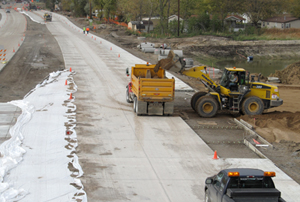
Grading of the new ramp from eastbound Hwy 10 to Ramsey County Road 96 continues in Arden Hills. The new lanes of County Road 96 are nearing completion for a mid-November opening. This view is looking west from the new eastbound Hwy 10 bridge. Photo by Kent Barnard |
Hwy 36 and English Street in Maplewood - Crews have replaced a signalized intersection at Hwy 36/English Street with a diamond interchange. Additional work included improvements to the County Road B/Hwy 61 intersection, removing the existing access to Hwy 36 at Hazelwood Street and Atlantic Street to improve safety, replacing the Bruce Vento Trail pedestrian and bicycle bridge, and improving drainage. This project will be complete by December. (Construction cost: $17.3 million)
Hwy 169 and County Road 30 Interchange - Completed in late October, this project removed the existing traffic signal at Hwy 169 and County Road 30 intersection and constructed a new interchange to improve safety and help alleviate congestion on Hwy 169 between Shakopee and Champlin. (Construction cost: $8.2 million)
Hwy 52/Lafayette Bridge - The new northbound Hwy 52/Lafayette Bridge will be completed at the end of 2013, at which time, traffic will be switched to the new northbound bridge. The existing Hwy 52/Lafayette Bridge will be demolished, and the new southbound Hwy 52 Bridge will be constructed in 2014. (Construction cost: $130.4 million)
Hastings Bridge over the Mississippi River - The project, which began in 2010, is scheduled to have all four lanes open to traffic in November, which will enhance mobility and safety for the region. Project completion is set for 2014. (Construction cost: $130 million)
I-35/I-35E Elko to Eagan - Work is nearing completion on a series of projects along this corridor, which included resurfacing repairs and upgrades from County Road 2 in Elko to Cliff Road in Eagan and painting bridges along I-35W. The project will be finished in 2014. (Construction cost: $20 million)
St. Croix Crossing connecting Oak Park Heights, Minn., and St. Joseph, Wis. –Construction on both the Minnesota approach work and bridge foundations work began in spring 2013. The bridge foundations work includes everything below the river surface and will be complete in early 2014. (Construction cost estimates: $580 million-$676 million)
Projects in northern and central Minnesota include:
I-535/Hwy 53 Blatnik Bridge Rehabilitation – The project, which involved high-end maintenance work designed to extend the life of the bridge, was completed in October. The work included, replacing expansion joints, traffic rail and lighting system, strengthening gusset plates, sandblasting and painting. (Construction cost: $12.9 million)
I-35 Unbonded Concrete Overlay from Scanlon to Proctor – This project was completed in October and provides motorists with 10 miles of smoother road surface for traveling. The project also included a reconstructed underpass at Hwy 61 and Guss Road and the completed reconstruction of Hwy 2 from Boundary Avenue to Skyline Parkway. (Construction cost: $30.1 million)
Hwy 9 between Ada to the Norman/Polk County line - Work is nearing completion on a 12-mile resurfacing project that also included the replacement of culverts along Hwy 9 and the installation of a sub-surface drain on Hwy 200 in Ada. (Construction cost: $5.02 million)
Hwy 15/County Road 120 in Sartell and St. Cloud - The project replaced an at-grade signalized intersection with a diverging diamond interchange and was completed in October. This is the second diverging diamond interchange to open in Minnesota, and the first with a fully operational signal system. The interchange is the final component of a multi-project initiative that improves safety and mobility on a system serving busy business districts and residential areas in two cities. (Construction cost: $10 million)
I-94 between Clearwater and St. Cloud – Work was completed in July on the project to repave 7.5 miles of one of Minnesota’s busiest roads using an unbonded concrete overlay, where new concrete pavement is placed over the existing pavement. The new pavement is expected to last 30 years. (Construction cost: $16.4 million)
I-94 cable median barrier installation – Installation of 30 miles of high-tension cable median barriers along I-94 in the Moorhead, Fergus Falls and Alexandria areas is complete. Crews will install cable median barriers in additional areas along I-94 next year. (Construction cost: $3.3 million)
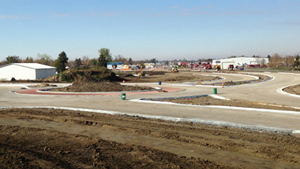
Construction on Hwy 60 from the Iowa state line to I-90 at Worthington, including two roundabouts, will finish in late November. Hwy 60 enters the Oxford Street roundabout at the bottom right and exits upper left. Photo by Poncho White |
Projects in southern Minnesota include:
Hwy 52 Cannon Falls Interchange – The two-year project began this year and is scheduled to be complete at the end of 2014. This project includes building an interchange in Cannon Falls and removing the final two traffic signals on Hwy 52 between Rochester and the Twin Cities. (Construction cost: $14.3 million)
Hwy 60 in Worthington – This is the last of three years of major improvements to Hwy 60 in the Worthington area, including realignment of the highway, a new Union Pacific Railroad bridge and roundabouts at key intersections. Landscaping is scheduled for 2014. (Construction cost: $45 million)
Hwy 15 in Hutchinson and Brownton – Several improvement projects in McLeod County were completed this year, including construction of a new roundabout in Hutchinson. Additional improvements include a new water main and sanitary sewer, resurfacing of Hwy 15 in Hutchinson, bypass lane construction on Hwy 15 in Brownton, street light installations, and pedestrian enhancements. (Construction cost: $5.2 million)
For a complete list of 2013 projects and their status, see www.mndot.gov/roadwork/current.html; and for studies and plans for possible future projects, visit www.mndot.gov/roadwork/future.html.
|
 |
|

|
 |
TABLE of CONTENTS
 |
District 4ís Lowell Crowell dies after long illness |
By Jerimiah Moerke, District 4 public affairs coordinator

Lowell Crowell worked in Detroit Lakes as a general maintenance worker and head groundskeeper. Photo courtesy of the Crowell family |
Lowell Crowell, District 4 general maintenance worker 3 in Detroit Lakes, died Nov. 2, at Essentia Health in Fargo, N.D., after a long battle with cancer. He was 59.
Crowell worked in facilities management in Detroit Lakes for more than 25 years. For most of those years, Crowell worked overnights as the third shift janitor. About three years ago he became head groundskeeper, which also meant he was responsible for snow removal.
“He really took pride in his yard here,” said Brian Kotschevar, District 4 facilities manager.
Crowell came in on weekends to make sure snow was cleared from the buildings for employees of MnDOT and the State Patrol.
“He was a very devoted MnDOT employee—always willing to go above and beyond,” Kotschevar said. “He took his job to heart and did it with a smile.”
Crowell was also a kidder—trying to get others to crack a smile. Colleagues say he stayed positive despite long-term health issues.
“I hardly ever heard him complain,” said John Gobel, who worked in the facilities department with Crowell. “He was just a lot of fun. He made me laugh.”
Gobel also said Crowell was always willing to lend a hand to help others in the office.
Outside of work, Crowell thought the world of his children. He enjoyed family get-togethers, fishing and gardening. He also enjoyed auctions, western novels and country music.
Crowell is survived by two adult children, Lisa Osse and David Bahlman; two grandsons; his mother, Mary; three brothers and three sisters. His obituary can be found at: http://www.dl-online.com/content/lowell-crowell |
 |
|

|
 |
TABLE of CONTENTS
 |
MnDOT is prepared for winter, but are you? |
|
By TK Kramascz
If you’ve been a licensed driver in Minnesota for any amount of time, you’ve seen them a thousand times—the dos and don’ts of winter driving and the snowplow safety messages.
The Nov. 5-6 snowfall gave most of us a dress rehearsal for what’s ahead, but it’s been about six months since we’ve really seen the sustained low temperatures and snow and ice that increase the hazards in an already inherently hazardous environment—the roads and freeways. Now would be a good time to review winter driving tips and re-visit the facts.
It starts with snowplows
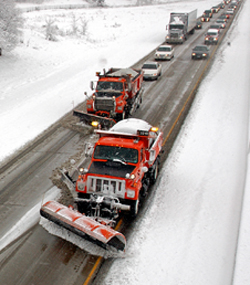
Snow and ice season is right around the corner. Itís time to dust off your winter driving skills. Photo by David Gonzalez |
Snow plows travel much slower than the posted speeds because it’s the most effective method for clearing roads and applying material. In addition, the plow driver’s field of vision behind the plow is restricted, and he or she relies on mirrors to see the rear and side of the plow.
Fully equipped trucks weigh as much as 15 times more than your average car. (Who do you think would win in a car versus snowplow collision?) Slow down, and allow for at least five car lengths between your vehicle and plows, and stay behind them. The road behind a plow is cleaner and clearer to drive on and they’re there to make your drive as free of snow and ice as possible.
“Returning roadways to good winter driving conditions is our top priority for snow and ice operation,” said Steve Lund, state maintenance engineer.
“MnDOT aims to return driving surfaces to clean and clear in short order, and motorists need to drive according to the weather conditions,” he added.
Keep your vehicle in shape for winter driving
Have your vehicle maintained regularly. Most service stations will inspect your tires and other equipment under the hood when you have your oil changed. Two things the cold can really affect are batteries and belts. Make sure they’re given the once-over when you go in for regular maintenance. Tires should have plenty of tread for better traction when things get slippery.
Know the rules
Turn on your headlights to increase visibility to other motorists when it’s snowing; this one’s a state law and covers vehicle lighting under all driving conditions.
- Slow down and leave plenty of room to stop when it’s icy; allow at least three times more space than usual between you and the vehicle in front of you
- Brake gently to avoid skidding and ease off the brake if your wheels start to lock up
- Use lower gears to keep traction, especially on hills
- Don't use cruise control
- Be especially careful on bridges, overpasses and infrequently traveled roads, which freeze first
- Even at temperatures above freezing, if the conditions are wet, you might encounter ice in shady areas or on exposed roadway segments, like bridges
- Even four-wheel and front-wheel drive vehicles can encounter trouble on winter roads
Remember: we’re in snow and ice mode together. Slow down; watch out for snow plows and use common sense. And don’t forget to dial 5-1-1 or visit www.511mn.org before you head out and get current road conditions all over the state. |
 |
|

|
 |
TABLE of CONTENTS
 |
New agency vision, strategic priority unveiled at MnDOT managersí conference |
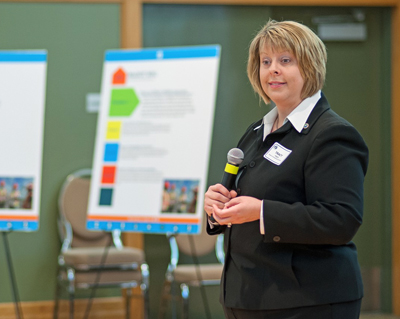
Tracy Hatch, deputy commissioner, spoke about the strategic priority of enhancing financial effectiveness during the Managers Conference at the Eagan Community Center Nov. 7. Photo by David Gonzalez |
Managers got the first peek at MnDOT’s new vision, mission, core values and strategic priorities last week at their two-day fall conference, which included presentations about the March 2014 Transportation Conference, the Corridors of Commerce program and agency budget, among other topics.
“This is our vision and this is the vision for the state of Minnesota,” said Commissioner Charlie Zelle, holding up a half-sheet of paper before an audience of about 165 managers.
“When we say ‘Minnesota’s multimodal transportation system maximizes the health of people, the environment and our economy,’ we didn’t make that up in the commissioner’s office. It comes directly from the Minnesota GO research, from what we heard from citizens, stakeholders and our staff. This has percolated over many years.”
In addition to the agency vision, Zelle talked about MnDOT’s:
- Mission – Plan, build, operate and maintain a safe, accessible, efficient and reliable multimodal transportation system that connects people to destinations and markets throughout the state, regionally and around the world.
- Core values – Safety, Excellence, Service, Integrity, Accountability, Diversity and Inclusion
- Strategic priority – Enhancing Financial Effectiveness
The strategic priority, also known as a “Wildly Important Goal” (a concept introduced by authors Stephen R. Covey and Chris McChesney), will be achieved through completing targeted projects in four strategic focus areas championed by senior management:
- Financial management (Sue Stein, Corporate Services Division director)
- Project management (Jon Chiglo, Engineering Services Division director)
- Asset management (Tim Henkel, Modal Planning & Program Management Division director)
- Information and outreach (Eric Davis, chief of staff)
“MnDOT uses billions of dollars each year to build and maintain the state’s transportation system. The public needs to trust that we are handling tax dollars effectively and efficiently,” said Tracy Hatch, deputy commissioner, chief financial officer and chief operating officer. “We all have a role in how we support the agency as it moves down this path.”
MnDOT managers will introduce the new vision and mission to employees this week and determine how the offices and sections will track progress. The agency will develop some management tools to help track the agency’s overall progress in moving towards its vision.
More information can be found at http://ihub.dot.state.mn.us/vision/. Watch for additional information in future issues of MnDOT Newsline. |
 |
|

|
 |
TABLE of CONTENTS
 |
New templates for presentations |
|
By Kay Korsgaard To support MnDOT’s new vision and mission, the Office of Communications posted revised templates for fact sheets, PowerPoint presentations, report covers and other documents to ihub.
Features of the new templates include:
- Increased accessibility in the layout of documents so they are easier to navigate for customers who are vision-impaired.
- Reduced use of blue backgrounds. PowerPoint templates are now available with a white background to save on ink when printed.
- Removal of the "Your Destination Our Priority" slogan. In most cases this has been replaced with “We all have a stake in A to B.”
Tips on best practices for creating accessible documents to ensure they are compliant with the Americans with Disabilities Act also are available.
Reminder – the correct abbreviation for the Minnesota Department of Transportation is MnDOT – no slash!
You can find the new templates and best practices at http://ihub/communications/mndottemplates.html.
Contact the graphics team at graphicsteam.dot@state.mn.us with questions about the templates or best practices. |
 |
|

|
 |
TABLE of CONTENTS
 |
Teams help safeguard MnDOTís assets, ensure proper use of resources |
By Sue Roe
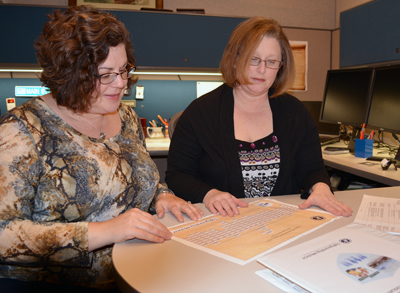
Susan Hall, left, and Suzie Thayer are leading the Control Environment Teamsí work as part of Safeguarding MnDOT. Hall is the Safeguarding MnDOT project manager and Thayer is program manager. Photo by Sue Roe |
Twenty Control Environment Teams, comprised of about 80 MnDOT employees, kicked off their annual review of the effectiveness and efficiency of the agency’s key internal controls Oct. 24. The teams’ goal is to ensure that the agency is safeguarding state assets, ensuring proper use of resources, complying with all applicable state and federal laws and regulations, and providing reliable financial information.
“We call these internal control teams the ‘eyes and ears’ of MnDOT,” said Susan Hall, Safeguarding MnDOT project manager. She said the teams’ work helps prevent fraud, waste and abuse of taxpayer-provided resources.
MnDOT has used internal controls for many years as a good management practice, Hall said. The Safeguarding MnDOT program began after a 2009 state law prompted the agency to formalize its efforts. The Control Environment is the foundation of MnDOT’s internal control program.
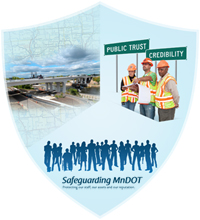
Safeguarding MnDOT is an internal controls program to safeguard staff, assets and reputation. Twenty teams of MnDOT employees work to improve the agency’s processes and uphold standards of fiscal accountability and responsibility. |
The teams review four key control environment factors: integrity and ethical values; structure, authority and responsibility; commitment to competence; and oversight responsibility. Through an assessment process, teams routinely review specific goals, objectives and recommended controls related to the four factors.
Hall said the results are a coordinated, historical document of MnDOT’s control environment that reports changes, actions and improvements needed to be addressed during the next assessment. Results also provide leadership with better quality information in a timely manner to plan for the future.
“As a state agency, MnDOT is looked upon as a leader in this internal control effort. We want to continue to proactively improve our processes and uphold our standards of fiscal accountability and responsibility,” Hall said.
For information or to provide input, employees can contact Hall or Suzie Thayer, program manager. |
 |
|

|
|

|
 |
TABLE of CONTENTS
 |
On the Job: Jim Brandt has inside track on rail safety |
By Greg Ruhland, Office of Freight and Commercial Vehicle Operations
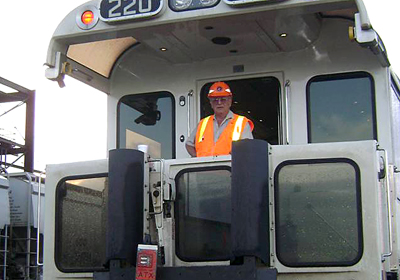
Jim Brandt has been inspecting railroad tracks around Minnesota for more than 30 years. MnDOT file photo |
Nearly three decades have passed since Jim Brandt began inspecting the tracks of Minnesota’s 25 railroads for quality and safety. Then, and now, he works alone. There is no MnDOT sidekick. No wingman. No backup.
It’s a big job. Brandt ensures that track and bridge conditions meet federal safety standards. He verifies that track crews have proper on-track protection in place for trains and that track equipment is in compliance with federal regulations. Occasionally, he might even investigate derailments and rail crossing collisions involving fatalities or hazardous materials. In between, there are public/labor complaints to investigate and rail project managers to assist.
Ever wish you could clone yourself?
All the time. Minnesota has several yards and terminals and 4,500 miles of mainline track to cover; it’s almost impossible for one person to cover. The Federal Railroad Administration has two other inspectors covering Minnesota and Wisconsin. We coordinate our inspections to make sure all the tracks get covered.
So, it’s time management 101…
At a minimum, I try to spend 125 days conducting track inspections. Most of these days occur from April to November. The rest of my time is spent following up on complaints, accident investigations, record inspections, riding trains and other specific issues.
What are some ways that inspections differ?
Because railroads are classified by maximum operating speed into five classes, I always have five sets of rules in my head. The Federal Railroad Administration maintains various levels of track safety standards for each class. If the railroad is operating at 25 mph, I follow the Class 2 standard. Another section of that same track could be 40 mph, so then I inspect it under the Class 3 standard.
How do you help railroad workers protect themselves and others?
Whenever crews are working on the track, I’ll make it a point to stop and visit, check what type of on-track protection they have, what time they need to clear the track for trains, whether other crews are working in the area and how are they protected. With the Class 1 railroads operating up to 70 trains per day at 40 to 80 mph, track crews have to know what’s going on at all times because there just isn’t any room for error.
If there are errors, what button do you push?
When a track does not comply with the requirements, the railroad must either bring the track into compliance or take the track out of service. Any violation found during my inspection is subject to a penalty. Violation reports and my recommendations are sent to the Federal Railroad Administration office in Chicago for review and handling.
Were you affected by the recent news story of a youth who was severely injured while playing on near tracks?
It raised the issue that safety is the number one focus of my job, whether it’s the safety of train operations or the safety of the traveling public or pedestrians. I cringe every time I hear a story about someone who suffers injuries because of a hazard that could have been prevented.
What do you wish there was more time to do?
Over the past few years the railroads have lost a lot of track experience due to retirements. I enjoy passing down my 45 years of knowledge to the younger generation on how to interpret rules or make a proper repair. The money to bring everyone up to speed on track standards is often lacking, especially in smaller “shortline” railroads that cannot afford the same training, personnel or equipment as larger Class 1 railroads. Inspecting and educating go hand-in-hand for me.
What do you educate your customers about most?
Safety. The FRA and railroads conduct several classes during the year and safety procedures and practices are discussed with personnel during inspections.
Do you or a co-worker have an interesting job to share with readers? Click here to send us your ideas, and we’ll contact you for more information.
Recent employee profiles:
|
 |
|

|
 |
TABLE of CONTENTS
 |
Frost Damage in Pavement |
|
Video covers the causes and cures for damage to pavement caused by frost. Video produced by the SRF Consulting Group and MnDOT Video Services |
|
 |
|
| |
|



